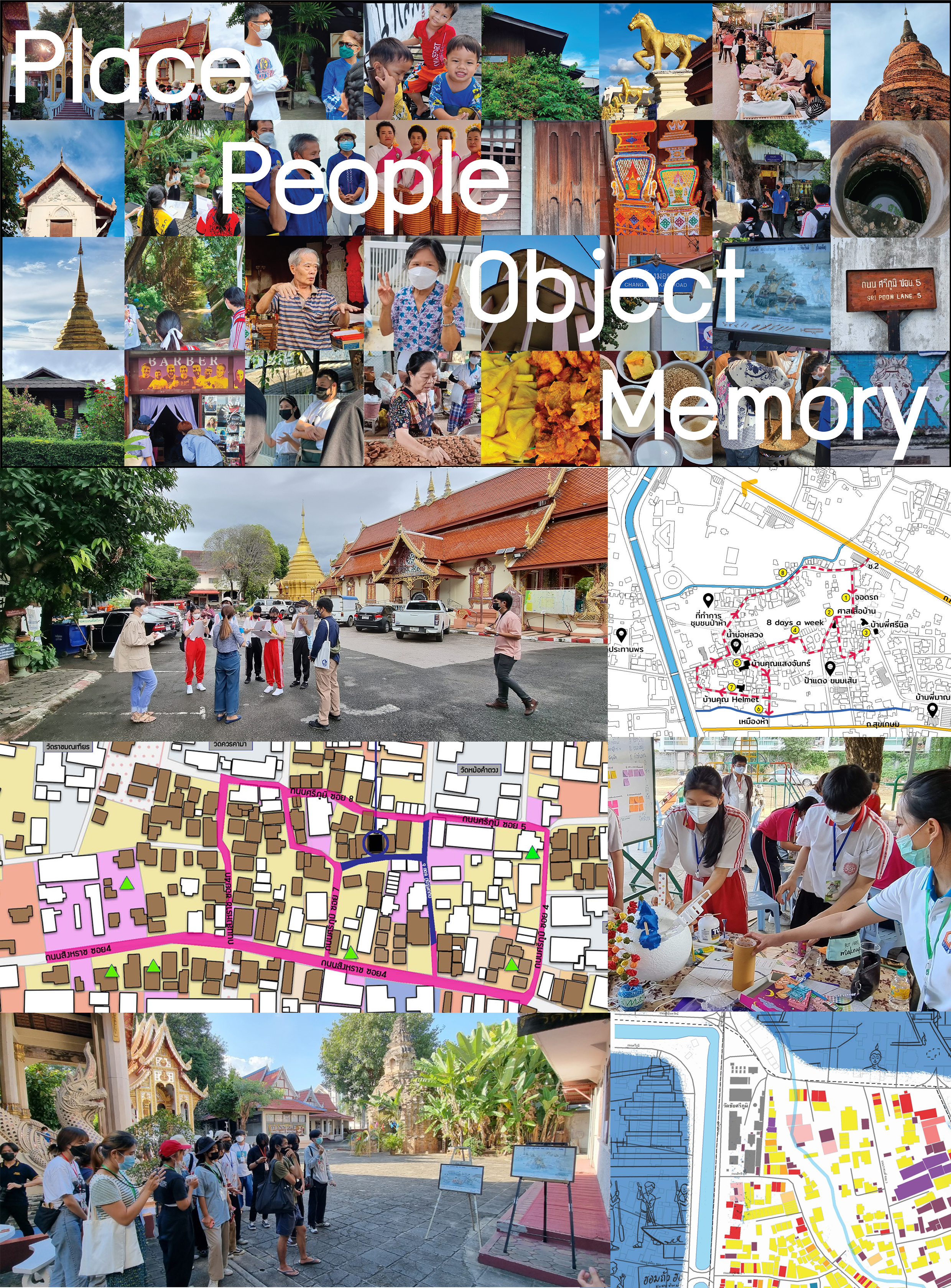สำรวจการก่อรูปทางความคิดและกลไกการขับเคลื่อนเชียงใหม่เมืองแห่งการเรียนรู้ด้วยชุมชน
Main Article Content
บทคัดย่อ
บทความวิจัยนี้เป็นส่วนหนึ่งของโครงการวิจัย “โครงข่ายท้องถิ่นเพื่อการเรียนรู้เมืองเชียงใหม่”
ที่ได้รับทุนสนับสนุนจากหน่วยบริหารและจัดการทุนด้านการพัฒนาระดับพื้นที่ (บพท.) ในปี 2564 ตามกรอบ “เมืองแห่งการเรียนรู้” (learning city) ของ UNESCO มีขอบเขตพื้นที่วิจัยในเขตเทศบาลนครเชียงใหม่
มีวัตถุประสงค์เพื่ออธิบายถึงการก่อรูปของวิธีคิดและกลไกการขับเคลื่อน โดยอาศัยทฤษฎีพื้นที่ทางสังคมของ
ฮองรี เลอแฟบร์ มาปรับใช้เป็นกรอบความคิดหลักในการสำรวจ “ชุมชนและพื้นที่ชุมชน” ใช้การสำรวจและแยกแยะองค์ประกอบของชุมชนในฐานะที่เป็นผลผลิตอย่างหนึ่งของพื้นที่และนำเอาองค์ความรู้ต่าง ๆ ที่ได้
มาสร้างเป็น บทเรียนเมือง โดยกระบวนการสกัดทรัพยากรและองค์ความรู้ชุมชนจาก 4 องค์ประกอบ คือ
ผู้คนของชุมชน (people) สถานที่ของชุมชน (place) วัตถุของชุมชน (object) และ ความทรงจำของชุมชน (memory) นำไปสำรวจ จัดทำแผนที่ และชุดข้อมูลต่าง ๆ ของชุมชนเป้าหมายทั้งสาม คือ ชุมชนควรค่าม้า ชุมชนป่าห้า และชุมชนช้างม่อย ซึ่งการออกแบบกิจกรรมต่าง ๆ ในโครงการวิจัยตั้งอยู่บนการทำงานร่วมกันของสามโครงการย่อย หรือเรียกได้ว่า 3 ทิศทางของการเชื่อมร้อยทิศทางในการสร้างให้เกิดกระบวนการเรียนรู้เข้าด้วยกัน ในช่วงแรกแต่ละโครงการย่อยจะทำงานร่วมกันเพื่อทำความเข้าใจชุมชน ประวัติศาสตร์ความเป็นมา ปัจจัยทางกายภาพและทางสังคม เรียบเรียงเป็น บทเรียนเมือง โดยที่แต่ละโครงการได้มีจุดเน้นในการลงรายละเอียดที่
แตกต่างกัน เช่น โครงการย่อยที่ 1 เน้นการระบุและวิเคราะห์เครือข่ายเชื่อมโยงระหว่างการทำงานของชุมชนและภาคประชาสังคม โครงการย่อยที่ 2 เน้นการวิเคราะห์ความสัมพันธ์ของชุมชนกับการเปลี่ยนแปลงทางพื้นที่กายภาพเมือง และโครงการย่อยที่ 3 เน้นการค้นหากระบวนการเรียนรู้ที่เกิดขึ้นกับเยาวชน โดยการออกแบบเชิงปฏิบัติการ
เรียนรู้ในพื้นที่ร่วมกับบทเรียนเมืองสำหรับเยาวชน การวิเคราะห์เครือข่ายท้องถิ่น จากการสกัดองค์ความรู้และทดลองผ่านกระบวนการเรียนรู้ที่เกิดขึ้น พบว่า (1) โครงสร้างของชุมชนในเขตเทศบาลหลาย ๆ ชุมชนมีความ
เปราะบางมาก หากขาดการทำงานที่ต่อเนื่อง ย่อมส่งผลต่อความเข้มแข็งของชุมชนได้ (2) การสร้างเครือข่ายการเชื่อมโยงเป็นไปได้ด้วยความยากลำบากและล่าช้า เพราะขาดการสื่อสารที่ดี และ (3) ชุมชนต้องการแผนการดูแลชุมชนที่มากไปกว่าระบบการพัฒนาทางกายภาพของพื้นที่
Article Details

อนุญาตภายใต้เงื่อนไข Creative Commons Attribution-NonCommercial-NoDerivatives 4.0 International License.
เอกสารอ้างอิง
Daungthima, W. & Tansukanun, P. (2018). Neawtang karn pattana laweak baan lae yarn nai mueang Chiang Mai. (In Thai) [Development of neighbourhood and districts of Chiang Mai city]. Journal of the Faculty of Architecture, Vol.27(2), 134-151.
Kearns, P. (2015). Learning cities on the move. Australian Journal of Adult Learning, 55(1), 153-168.
Lefebvre, H. (1991). The production of space. Oxford: Blackwell.
Longworth, N. & Osborne, M. (2010). Six ages towards a learning region – a retrospective. European Journal of Education, 45(3), 368-406.
Niwatmankha, S. (2018). Khwam samphan khong withi khwamchuea lanna lae karn thongthiao choeng niwet prawattisat nai khet mueang kao Chiang Mai. (In Thai) [The relationship of the Lanna way of faith and historical ecotourism in the old city of Chiang Mai]. Proceeding of UTCC Academic Day (pp. 1129-1149). Bangkok: University of the Thai Chamber of Commerce.
Nutsati, N. (2020). Khrongkarn chattham phaen phuea anurak lae phatthana Chiang Mai mueang thongthiao wattanatham 4.0. (In Thai) [Chiang Mai preservation and development plan project cultural tourism city 4.0]. Retrieved August 2, 2020, from https://voiceofchiangmai.org/2020/04/28/Naphat-Nutsati/
Ongkul, S. (2003). Khrongkarn wichai prawattisat chumchon nai Chiang Mai: karn sang prawattisat thongthin. (In Thai) [Chiang Mai community history research project: creating local history]. Chiang Mai: Thailand Science Research and Innovation (TSRI).
Opaspattanakit, A. (2020). Khrongkarn karn chattham phuentee thang wattanatham phuea sanapsanun karn khapkhluean mueang Chiang Mai pen khrueakhai mueang sangsan khong ongkarn UNESCO (sakha hatthakam lae sinlapa phuenban). (In Thai) [Cultural mapping for supporting Chiang Mai creative city network of UNESCO (crafts and folk art)]. Bangkok: Office of the National Research Council of Thailand.
Prachanawutthisarn, K. (2009). Karn khlueanwai khong pracha sangkhom nai mueang Chiang Mai tor praden panha tee kerd chak khwam pen mueang rawang pi phoso 2540-2551. (In Thai) [The movement of civil society in Chiang Mai on issues arising from urbanization during 1997-2008]. Retrieved April 10, 2021, from http://cmuir.cmu.ac.th/jspui/handle/6653943832/64876
Promthed, A. & Khutrakun, A. (2019). Karn borihan pokkhrong chumchon mueang phaitai boribot khwam laklai phuea karn pen chumchon thuathueng: koranee sueksa yarn chumchon Wat Kate changwat Chiang Mai. (In Thai) [Urban governance in diversity for inclusive community: a case study of Wat Kate area, Chiang Mai province]. Political Science and Public Administration Journal of Chiang Mai University, 10(2), 85-108.
Research Team. (2020). Khrongkarn khapkhluean Chiang Mai su mueang moradoklok. (In Thai) [Research project driving Chiang Mai to world heritage city]. Retrieved August 2, 2020, from http://edu.chiangmaipao.go.th/
Satsue, S. & Ongsavangchai, N. (2020). Pattanakarn khong karn chat rup tee wang lae ongprakob mueang phainai khet mueang kao Chiang Mai. (In Thai) [The development of spatial organization and urban elements in Chiang Mai old town]. Built Environment Inquiry Journal (BEI), 19(2), 43-62.
Shummadtayar, U. & Ongsavangchai, N. (2018). Karn kayai tua khong mueang kap karn plianplaeng boribot khong yarn mueang kao nai Chiang Mai. (In Thai) [Urbanization and urban context variants of old districts in Chiang Mai]. Journal of Environmental Design, 5(1), 60-81.
Suwatchapinun, S. (2015). Phap sathon khong khwam thansamai: banthuek lae thopthuan botbat khong sathapattayakam samaimai mueang Chiang Mai rawang pi phoso 2427-2518. (In Thai) [Reflection of Modernity: Rethinking the Role of Modern Architecture in Chiang Mai During 1884-1975]. Retrieved April 27, 2022, from http://research.culture.go.th/medias/nt156.pdf.
Tansukanun, P. & Daungthima, W. (2012). Neawtang karn pattana khwam pen yarn lak miti khong mueang Chiang Mai. (In Thai) [The multi-layered districts of Chiang Mai city]. Chiang Mai: PuPae Publishing.
Tansukanun, P. & Daungthima, W. (2017). A ‘sense of place’ of the neighborhoods in historic cities: the case of Chiang Mai, Thailand. Built Environment Inquiry Journal (BEI), 16(1), 85-107.
UNESCO. (2015). UNSECO global network of learning cities: guiding documents. Retrieved April 29, 2022, from https://uil.unesco.org/fileadmin/keydocuments/LifelongLearning/learning-cities/en-unesco-global-network-of-learning-cities-guiding-documents.pdf.


